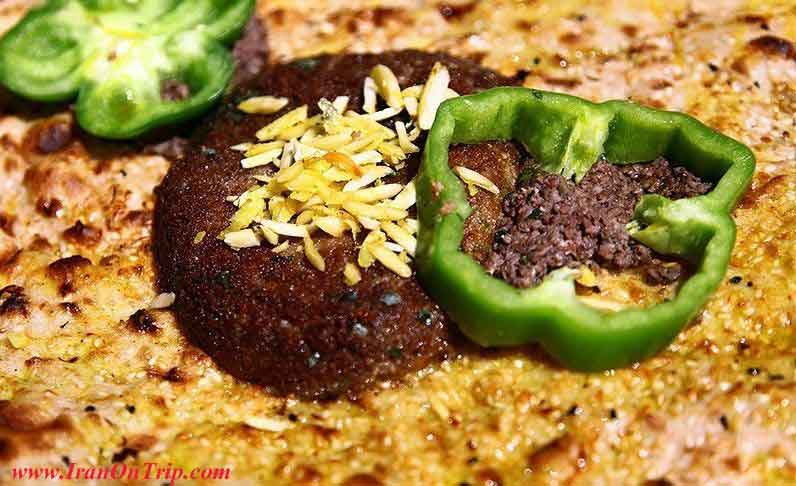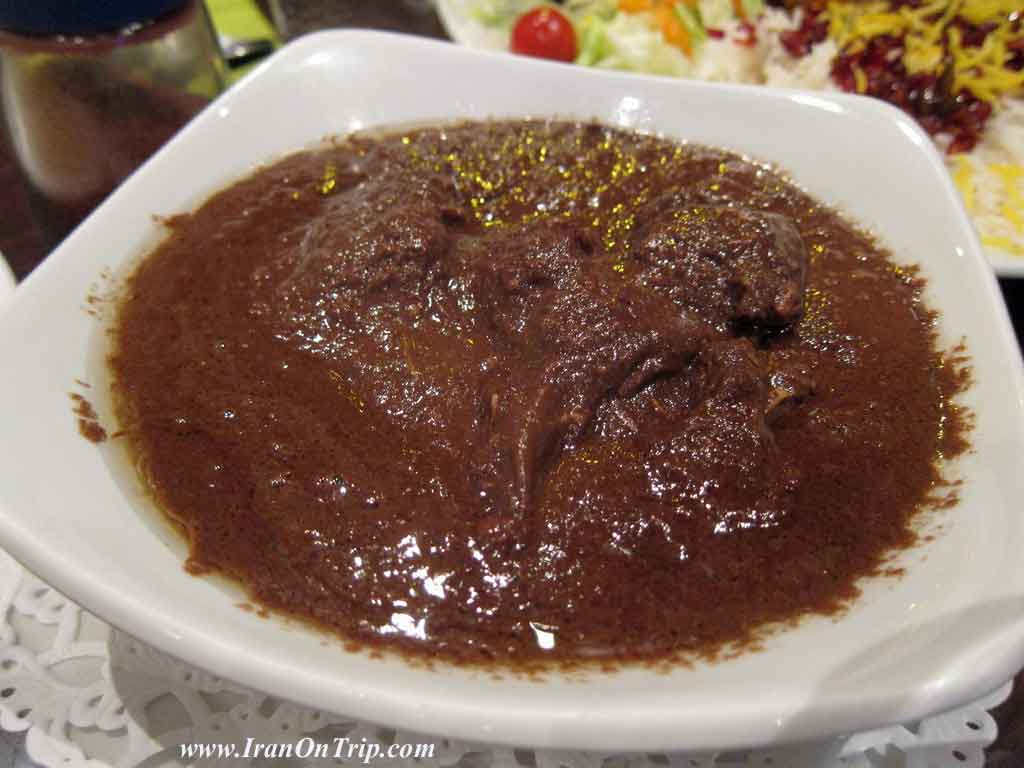Isfahan cuisine
Restaurants in Isfahan
Restaurants in Isfahan serve both local Iranian cuisine, fast food and international delicasies. Dishes are usually of high quality and prepared of fresh ingredients. Rice is the staple food in Iran cuisine, often served coloured or flavoured. Iranian food is not ususally spicy. Rice is often served with meat or chicken. The most popular Iranain dish is a rice and kebab dish named Chelo Kebab. It is often served with vegetables like onions and tomatoes. Food is very reasonably priced. As alcohol is illegal in Iran it is not served in restaurants in Isfahan.
The most famous traditional dishes in Isfahan are:
Berian/Beryun/Biryani

The most famouse dish in Isfahan is Beryani which is known in all of Iran as Isfahan food.This dish is made of mutton or lamb which is ground/minced and then cooked on one side in a special small pan over open fire. Berian is generally eaten with a certain type of bread, known as "nan-e-taftun".
Khoresh-e fesenjan

Khoresh-e fesenjān (Persian: خورش فسنجان), or simply fesenjan (Persian: فسنجان), is a dish in Persian cuisine and Mesopotamian cuisine. It is a thick, tart stew made from pomegranate syrup and ground walnuts (see bazha). It is traditionally made with poultry (duck or chicken); but also variants using balls of ground meat, ghormeh cut lamb, fish, or no meat at all are not unusual. Depending on the cooking method, it can have sweet or sour taste. It is served with Persian white or yellow rice (called polo or chelo).
Ingredients
• 1 to 2 large yellow onions, chopped, (3 cups)
• 2 Tbps unsalted butter
• 3 Tbsp olive oil
• 5 Tbsp Pomegranate Molasses
• 1/2 pound walnut halves (about 2 cups)
• 2 lbs boneless skinless chicken thighs and/or breasts
• 2 cups chicken stock
• 2 Tbsp plus 2 teaspoons of sugar
• 1/2 teaspoon turmeric
• 1/4 teaspoon cinnamon
• 1/4 teaspoon ground nutmeg
• 1/4 teaspoon ground black pepper
• salt
Procedure
1. Prepare the chicken by trimming the excess fat and cutting it into bit-size pieces. Pat the pieces dry with a paper towel and sprinkle them with some kosher salt.
2. Toast the walnuts. You can do that one of two ways. You can either spread them out in a single layer in a large skillet, and toast them on medium high heat, stirring frequently until lightly toasted, or you can spread them out in a single layer in a rimmed baking sheet, and toast at 350°F in the oven for 8 to 10 minutes. In either case, once toasted, remove from heat and allow to cool. Once cool enough to handle, pulse in a food processor or blender until finely ground.
3. In a large pan, heat 1 tablespoon of butter and 2 tablespoon of olive oil over medium-high heat. When the butter has melted, pat the chicken pieces dry again and place the chicken pieces in the pan, working in batches if necessary to not crowd the pan, and cook until golden brown on all sides. Sprinkle the chicken with salt while they are cooking.
4. Use a slotted spoon or tongs to remove the chicken from the pan, set aside. Add a tablespoon of butter and a tablespoon of oil to the pan. Lower the heat to medium low. Add chopped onions to the pan and sauté until translucent, stirring on occasion to release the browned bits from the bottom of the pan.
5. Return the chicken pieces to the pan with the onions. Pour 2 cups of chicken stock over the chicken and onions. Bring to a boil, reduce to a simmer, cover and simmer gently for 30 minutes.
6. Stir in the ground walnuts, pomegranate molasses, sugar, and spices. Cover and cook on very low heat for 1 hour, stirring every 20 minutes or so to prevent the walnuts from sticking to the bottom of the pan.
7. Remove from heat and adjust sugar/salt to taste. At this point the chicken should be fall apart tender.
KHORESHT MAST ESFAHANI

"Beef Yogurt"
• 1/4 lb (113g) Beef Neck
• 5 Tbsp Plain Yogurt
• 1/4 Tsp Saffron
• 1 Small Onion
• Turmeric
• 1 Egg Yolk
• 1/2 Cup Sugar
PREPARATIONS:
1- Soak the zafran (saffron) in boiling water for 30 minutes.
2- Boil 3-4 Cups of water.
DIRECTIONS:
1- Place the beef in a pot. Cut the onion in half and put it in the pot.
2- Add turmeric and pour in boiling water until it covers the beef, cover the pot with a lid.
3- Simmer the pot over low heat for 45 minutes (until beef is fully cooked).
4- Shred and mash the beef with a hand blender.
5- Beat the egg yolk in a pot.
6- Add the sugar (1/2 cup) to the pot and stir.
7- Add 5 tbsp of plain yogurt (Add more yogurt if the mixture is still thick) and blend thoroughly until well mixed.
8- Heat the pot over low heat and keep stirring.
9- Continue stirring until the mixture becomes creamy.
10- Add the mashed beef to the pot and continue stirring until well mixed.
11- Add the saffron to the pot and continue stirring until well blended.
12- Leave the mixture at room temperature until it cools down then place it in the refrigerator.
13- Serve cold. Decorate with pistachios and dried barberries.
Gaz (candy)
.jpg)
Gaz is a sweet that originates from the city of Isfahan, located in the central plateau of Iran . Gaz is derived from the juices and stems of a desert plant called angebin which is a member of the Tamarisk family, native to the Zagros Mountains range located to the west of the city. The plant is associated with manna, a food mentioned in the religious texts of the Abrahamic religions. The juice is combined with other ingredients including pistachio or almond kernels, rosewater and egg white.
Typically, Gaz nougats are not individually wrapped, rather they are packed together in a box and dusted with flour to keep the pieces from sticking to one another. They may be cut into bite-sized pieces, but are more often sold in larger sizes.
How It's Made
Traditionally, the juice and stems were collected from the mountains and brought into town where it was put into copper vessels. The raw mixture was then beaten until it reached the desired consistency and fashioned by hand into the desired shape. This process is still carried out in modern day Isfahan.
Preparation
Once collected from the mountains, the "gaz" (in Persian : گز) of Khunsar is brought into town and placed into very large copper vessels which contain the remaining ingredients of egg white, pistachio or almond kernels, and rose water. The raw mixture is then beaten over heat until it reaches the desired consistency.
Traditionally (and still today) gaz-nougat is handmade and fashioned into individual round pieces of about 2–3 inches in diameter and half an inch in thickness- packed into a wooden box (nowadays cardboard, metal or plastic boxes are used) and covered with plain flour to keep the pieces from sticking to one another. They may be cut into bite-sized pieces, but are more often sold in larger sizes. Gaz in flour is called "gaz-e-ardi"'.
In modern times and with the advent of automated machines capable of mixing, cutting and wrapping individual bite-sized pieces of gaz, production has increased to commercial levels.
.....
.....
.....

.jpg)



























